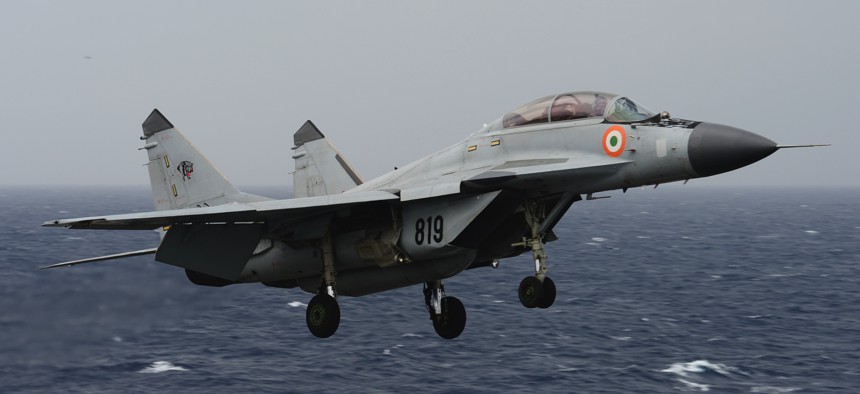
An Indian navy MIG-29K "Fulcrum" flies over the aircraft carrier USS Nimitz (CVN 68) during Exercise Malabar 2017. U.S. Navy
To Deter China, Deepen the US-Indian Partnership
Here are some ideas for the upcoming 2+2 defense and foreign affairs ministerial conference.
The Indo-Pacific is shrinking, and there are few remaining uncontested waters. New powers are rising, and not all support the ideals of rule of law and transparency. Strengthening the U.S.- India maritime security partnership will be of increasing importance in coming decades.
Fortunately, our countries’ security relations are also on the rise. India and the United States have expanded the scope and depth of their discussions and exercises. Cooperative agreements that seemed near-impossible a few years ago have been signed, with others on the near horizon. New Delhi has access to a much higher level of U.S. defense technology. And India has taken other visible steps to become a core security partner anchoring the South Asia region. But the “easy wins” are fewer, and some hard choices lie ahead. Our shared interest in a free and open Indo-Pacific must shape our next phase of cooperation.
The primary challenge is from China, which is expanding its reach and influence into the region. Delhi has long been aware of these efforts; the United States, to some extent, is still waking up to them. Among the tools Beijing is using to shape geopolitics in the Indian Ocean region are:
- Active naval operations, primarily anti-piracy submarine missions off the African coast;
- Strategic infrastructure financing, including of Hambantota Portin Sri Lanka, Gwadar Port in Pakistan, and Kyaukpyu in Myanmar;
- Increasing military presence, notably the naval port and extensive military facilities in Djibouti;
- Economic cooperation, including the China-Pakistan Economic Corridor and investments in Nepal, Myanmar, Maldives and Sri Lanka.
Our nations must also think through what other tools China may choose to employ in the future. It is unlikely Beijing’s attempt to expand its influence in the Indian Ocean region will directly mirror its operations in the South China Sea, unless it “discovers” an analogue to the 9-Dash Line to stake a physical claim in the region. But China could, for example, choose to:
- Compel client states like Pakistan to employ harassing measures such as using fishing vessels and merchant marine ships;
- Seek to acquire additional naval bases in the region; Co-opt regional partners to expand intelligence-sharing agreements, such as monitoring U.S. and Indian naval movements;
- Deter American and Indian private sector trade and investments from high-growth markets in the region;
- Deploy Chinese 5G technology, deterring potential intelligence-sharing with countries in the region;
- Threaten the supply of strategic materials such as rare earths from the region;
- Block access to information, such as news on anti-China protests in Hong Kong;
- Attempt to extract minerals from the 200-mile Exclusive Economic Zone of Indian Ocean nations’ littoral;
- Deploy an aircraft carrier group in the Indian Ocean.
Related: America Can't Duck the India-Pakistan Crisis
Related: How Smaller States are Choosing Sides in the Indian Ocean
Related: US Marines Try Using Drones to Bring Blood to Battle
To push back on and deter China, the U.S. and India must develop and deploy a complementary set of tools. Last month, the U.S.-India Maritime Security Cooperation working group convened by Delhi Policy Group and Center for Strategic and International Studies (and including the two authors of this piece) released recommendations for deepening security cooperation. Beyond continuing efforts to deepen interoperability, India-U.S. cooperation in the Indo-Pacific must set the table for expanded security cooperation by:
- Enlarging U.S. interest in the region. A wider range of U.S. security experts must recognize China’s growing interest in the Indian Ocean region. The Indo-Pacific cannot be a “Hollywood to Bollywood” map, as is often characterized.
- Publicizing India’s many independent actions to support a stable Indian Ocean region. One recent example was the Indian Army’s defense of Bhutanese territory during the 2017 Doklam standoff with China. Such moves align perfectly with U.S. goals for the region, yet India receives little credit for them—and therefore misses an opportunity to whet Washington’s enthusiasm for new cooperative efforts.
- Deepening U.S.-India strategic conversations and planning. India feels that U.S. engagements on issues like Afghanistan and Iran are more or less afterthoughts, or even diktats instead of conversations between partners. Such conversations will also be important as we attempt to define the roles of small-group initiatives such as the U.S.-India-Australia-Japan Quadrilateral, or our range of trilateral discussions with Indo-Pacific partners such as the U.S.-India-Japan trilateral.
A September 2018 2+2 Ministerial Dialogue brought our defense and foreign affairs ministries together in New Delhi to produce agreements on Indian access to Central Command, communications interoperability, and a new tri-service exercise. A second such meeting is expected in coming months. We urge our countries to bring some of these ideas to the table.



